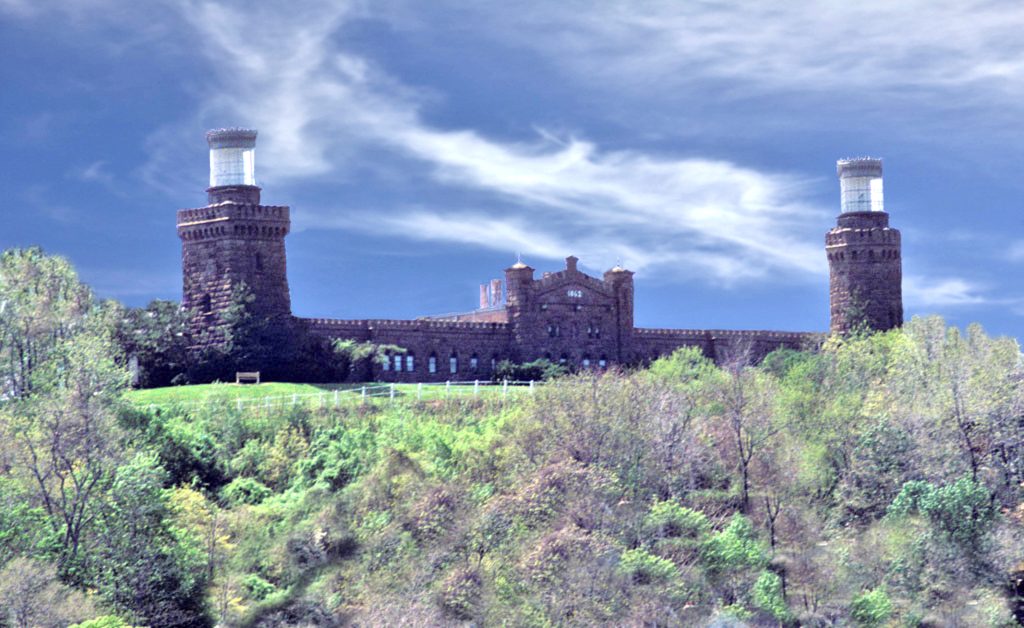
Highlands of Navesink was a natural vantage point for a lookout post. At 200 feet above sea level, approaching ships could be spotted at a distance of nearly 20 miles. During the 1740s, Great Britain and France and their allies were in a conflict called the War of Austrian Succession. British colonial authorities feared that New York Harbor and its commerce might be an opportune target for French war vessels. Thus, in 1746, the colony established an outpost at Highlands. As vessels approached the coast, watchmen were instructed to ascertain their nationality. During the day, if they proved to be enemy ships, large balls were hoisted up a 108-feet tall pole as a warning to observers on Staten Island. At night, the signal consisted of a raised pot of lighted oil.
A short time after its establishment, the night warning beacon was accidentally lit and hoisted to the top of the pole. But, no one even noticed it from their New York outpost, questioning the reliability of the warning signal. Luckily, two years later, the war ended and the system was retired.

The approaches to New York Harbor, with their numerous shoals, were hazardous. As the port grew, so did the number of area shipwrecks. The need for navigational aids was obvious. A lighthouse at Sandy Hook (New Jersey) was established in 1764 (it is still in service). A local newspaper, the New York Mercury, described it as an octagonal shape with a beacon lighted by “48 oil blazes.” Additionally, in 1823, the Sandy Hook Lightship, a 90-foot long, 23-feet beam vessel, was anchored in 85-feet of water, about 13 miles east, southeast of the Sandy Hook Lighthouse.
As early as the mid-1700s, the need for a lighthouse at Highlands of Navesink was also voiced by mariners. Two towers built of blue split stone were finally erected in 1828. Their construction, however, proved to be filled with structural flaws. Repairs were made and in 1841, both towers were equipped with a Fresnel lens. They were the first lighthouses in the Nation to be equipped with the French created, highly efficient beacon apparatuses. The lens concentrated the light into a relatively narrow beam, making it vastly superior to any other beacon device. By the start of the American Civil War, most of the Nation’s lighthouses were equipped with a Fresnel lens.
Over time, Navesink’s original twin towers continued to deteriorate. They were replaced in 1862 with castle-like towers connected by a 288-feet long, 18 room dwelling. It allowed its keeper and his assistants to service the beacons without exiting the structure.
In September 1899, Navesink added to its list of “firsts” in the United State when Guglielmo Marconi, the inventor of a system of wireless telegraphs, demonstrated its practical use in ship-to-shore communications from the lighthouse. The success of the demonstration prompted the New York Herald to enlist Marconi to relay the results of America’s Cup Race to the newspaper in October of that year. It was the first commercial use of the wireless telegraph.
The yachts were lined up just off Sandy Hook Lightship. At the sound of the starting gun, the British yacht Shamrock surged ahead of the American yacht Columbia. She was leading by 43 seconds. However, an hour later, Columbia passed her opponent and finished ahead of her. Columbia managed to win all three races against Shamrock.
Following the 1883 Chicago’s World’s Fair, a French seven-ton bivalve lighthouse lens, which had been on display at the fair, was sold to Navesink where it was installed in the south tower. Consisting of 386 separate lenses surrounding a bull’s eye lens, the electrified apparatus produced a 25-million candlepower light, visible 22 miles out to sea. The lighthouse was the most powerful beacon in the Nation. However, when local residents complained that the brilliant beacon preventing them from sleeping, so landward darkened panels were installed.
In 1917, Highlands was also the first to be equipped with the then experimental radio beacon. When equipped with the device, a ship could determine its position in relation to the radio beacon’s signal. Eventually, about 200 of the devices were installed at coastal lighthouses, along with some on the Great Lakes.
During World War ll, the amount of light projected from Navesink’s twin lights was reduced. Less than a decade later, the station was deactivated by the U.S. Coast Guard. The station was turned into a museum that later became designated as a State and National Historic Place. The huge lens that once occupied the south tower was dismantled and exhibited at the Boston Museum of Science. But in 1979, it was returned where it is on display at the Twin Lights of Highlands Museum. The center of the building, which functions as the museum, exhibits a large number of devices that were an important part of lighthouse equipment. In addition, it also has a large collection of artifacts from Life Saving Service, a predecessor of the United States Coast Guard. Visitors also have access to the north tower from which there is a great panoramic view of the ocean, the approaches to New York Harbor and the New York skyline.
A trip to the Twin Lights Museum is worthwhile at any time. It is open daily from 10 am to 4 pm, and admission is free. Also be sure to visit nearby Hartshorne Woods Park with its miles of trails, military bunkers, beach and fishing pier. For more information go to: https:/.www.trinlightslighthouse.org.
